Disclosure: This article contains affiliate links. We may earn a commission from purchases at no extra cost to you, which helps our travel content.
Standing at the edge of a Santorini vineyard, I found myself captivated by the same sense of reverence I first experienced at the Parthenon as a 12-year-old. The ancient basket-trained vines, twisted into protective circles against the fierce Aegean winds, represent a viticultural tradition dating back 3,500 years—a distributed knowledge system that has survived volcanic eruptions, conquests, and the passage of time. As a blockchain developer, I recognize these vineyards as living ledgers—decentralized repositories of cultural wisdom that have remained intact despite countless potential points of failure. During my recent spring sojourn to this crescent-shaped volcanic jewel, I discovered that Santorini's gastronomic landscape mirrors the island's dramatic topography: layered with history, shaped by volcanic forces, and offering revelations with each careful excavation. Join me as I decode the terroir-to-table experience that makes Santorini a sanctuary for those seeking the divine intersection of food, wine, and ancient wisdom.
The Alchemy of Volcanic Terroir
The relationship between Santorini's volcanic soil and its viticulture represents one of the most fascinating natural consensus mechanisms I've encountered. Unlike traditional vineyards that follow neat, predictable rows, Santorini's vines grow in a unique kouloura system—circular baskets that protect the grapes from harsh winds and intense sun while maximizing the limited water available from morning dew.
During my tour of Domaine Sigalas, located near Oia, I learned how the island's distinctive terroir—volcanic ash, pumice stone, and solidified lava—creates a minerality in the wines that cannot be replicated anywhere else on earth. The indigenous Assyrtiko grape, which comprises about 70% of Santorini's vineyards, has adapted to these harsh conditions over millennia, developing a remarkable resilience that parallels the distributed fault tolerance we strive for in blockchain architecture.
"These vines are sometimes over 200 years old," explained my guide, Maria, as she showed me roots that descend up to 20 meters into the volcanic soil. "They've never been affected by phylloxera because the pest cannot survive in this mineral-rich, ashy soil."
The result? Wines with extraordinary complexity: high acidity balanced with intense minerality and subtle citrus notes. After comparing several vintages, I invested in a bottle of 2018 Santorini Barrel Fermented Assyrtiko to bring home—a liquid artifact containing centuries of agricultural knowledge.
For serious wine enthusiasts planning a similar journey, I recommend bringing a specialized wine travel case to safely transport your vinous treasures back home. Mine has accompanied me from Burgundy to Napa and now the Cyclades without a single casualty.
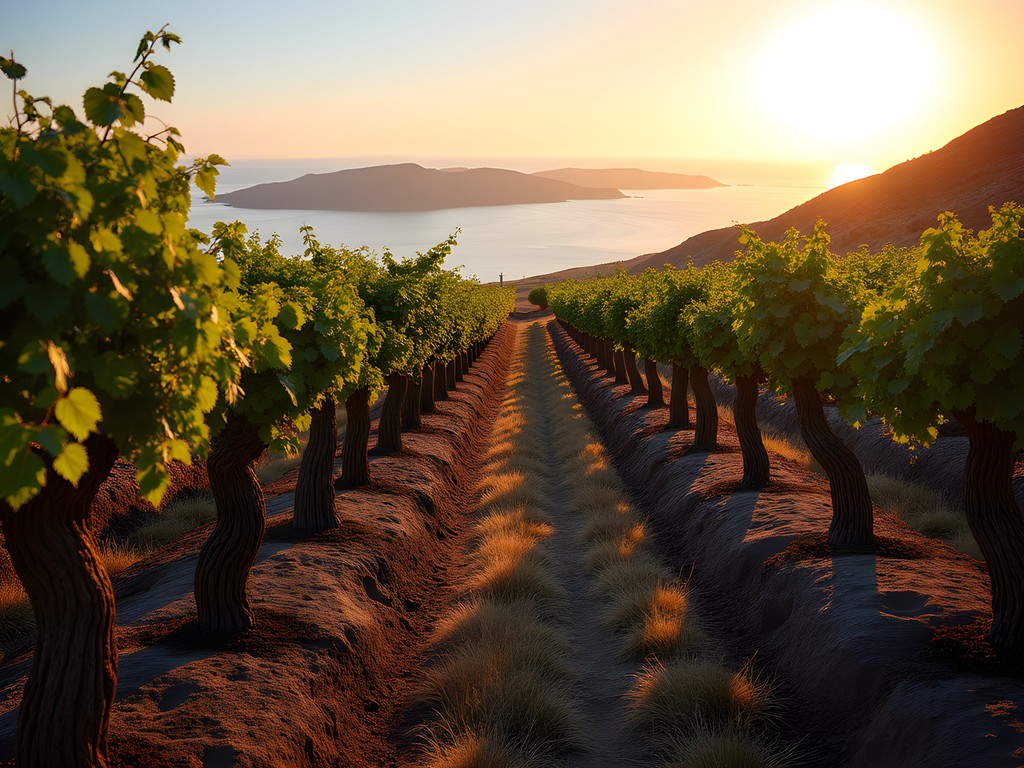
💡 Pro Tips
- Book winery tours at least 2 weeks in advance during spring season
- Visit vineyards in the morning when temperatures are cooler and your palate is fresher
- Try vinsanto last during tastings—its sweetness can overwhelm your ability to appreciate dry wines
The Sacred Geometry of Santorinian Cuisine
If Santorini's wines represent the island's soul, then its cuisine forms the corporeal vessel—simple yet profound, built on ingredients that have adapted to thrive in this seemingly inhospitable environment. The gastronomic traditions here follow what I've come to think of as a form of sacred geometry: precise combinations of humble elements that create something greater than the sum of their parts.
At Selene, a restaurant that has championed authentic Santorinian cuisine since 1986, I experienced this alchemy firsthand. Chef Thodoris Papanikolaou's tasting menu reads like a topographical map of the island—each dish highlighting microterroirs and hyperlocal ingredients.
"Our cherry tomatoes contain half the water but twice the sugar of conventional varieties," Chef Papanikolaou explained as he presented a deconstructed version of tomatokeftedes (tomato fritters). "They've evolved to concentrate flavor despite minimal irrigation."
The white eggplant of Santorini similarly tells a story of adaptation—developing its pale color to reflect rather than absorb the intense Mediterranean sun. When prepared as melitzanosalata, its smoky sweetness creates a perfect counterpoint to the saline minerality of the local Assyrtiko.
My most profound culinary revelation came from the humble fava—not the bean we know elsewhere, but a yellow split pea that has been cultivated on the island since antiquity. At Aktaion, a family-run taverna operating since 1922, their fava purée is served with capers, onions, and a generous stream of local olive oil. The dish exemplifies the Byzantine concept of xηρά τροφή (dry food)—sustenance designed to endure, much like the distributed ledgers I work with professionally.
For those wanting to recreate these flavors at home, I recommend investing in a proper Greek olive oil. The peppery finish and grassy notes will transport you back to the Cyclades with each drizzle.
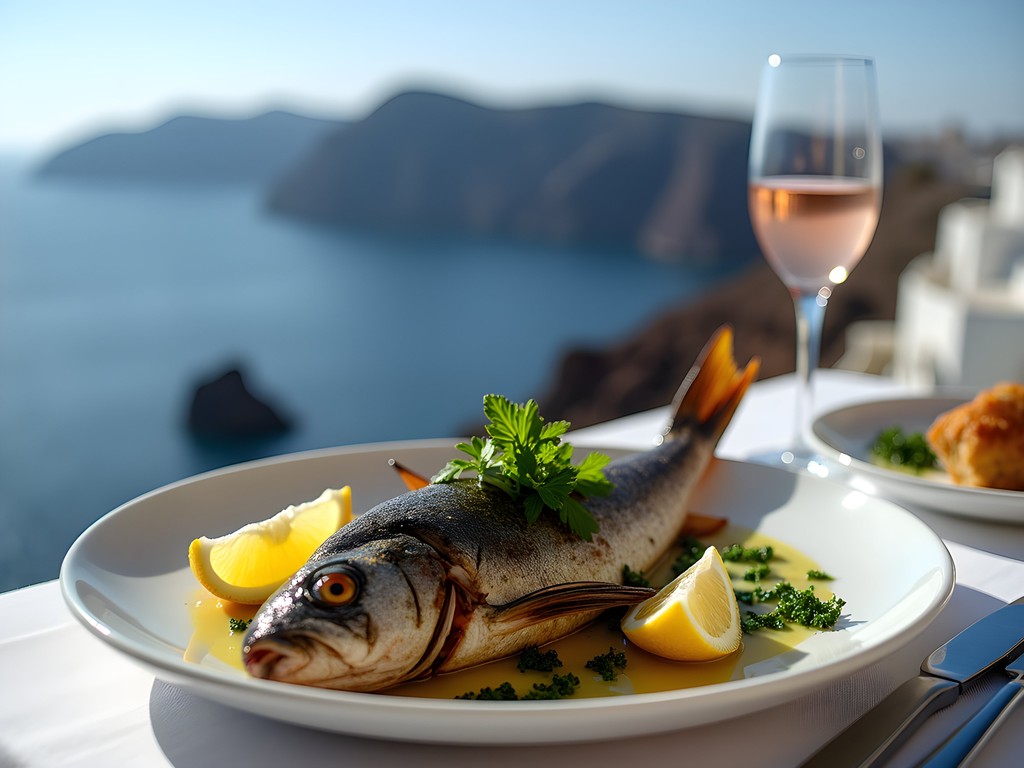
💡 Pro Tips
- Ask for 'ladolemono' sauce with fresh fish—a simple lemon-olive oil emulsion that enhances without overwhelming
- Try the white eggplant dishes, which are unique to Santorini and milder than their purple counterparts
- Order meze-style to experience the full spectrum of local specialties in one meal
The Ritual of Cliffside Dining
There's a particular alchemy that happens when exceptional cuisine meets Santorini's dramatic caldera views—a sensory convergence that elevates dining into a transcendent experience. While the island offers countless restaurants advertising sunset views, I've found that the truly memorable experiences come from establishments where the culinary vision matches the spectacular setting.
At Lycabettus in Oia, perched on a precipitous cliff edge, I experienced what can only be described as architectural gastronomy. The restaurant's cantilevered platform extends over the caldera like a modernist temple to culinary arts. As I worked through Chef Christos Athanasiou's tasting menu, I noted how each course seemed choreographed to complement the shifting light over the Aegean.
"We time the gold leaf dessert course to arrive precisely at sunset," explained the sommelier as she paired my baklava variation with a 20-year Vinsanto. "The reflection creates a dialogue between what's on your plate and the horizon."
For a more intimate experience, I discovered Lauda Restaurant, tucked away from the main tourist thoroughfares. Here, Chef Emmanuel Renaut has created a menu that draws parallels between Santorini's volcanic landscape and French culinary technique. The signature black cod with fava purée and bottarga demonstrates what he calls "culinary stratigraphy"—layering flavors to tell the geological story of the island.
For those seeking the ultimate cliffside dining experience without the crowds, I recommend booking the private dining terrace at Grace Hotel. My evening there began with a personalized cocktail consultation using local herbs and spirits, followed by a customized seven-course menu incorporating my preference for seafood and volcanic wine pairings.
To capture these magical dining moments, I relied on my low-light camera. Its exceptional sensor handled the challenging transition from bright afternoon to twilight without missing the subtle colors of either the food or the famous Santorini sunset.

💡 Pro Tips
- Book cliffside restaurants at least a month in advance and request specific tables for optimal sunset views
- Schedule dinner reservations for 7:00 PM in spring to witness the entire sunset progression during your meal
- Consider lunch at top restaurants for similar quality but lower prices and easier reservations
The Ancient Wisdom of Santorinian Wine Preservation
What fascinates me most about Santorini's wine culture isn't just the final product, but the ingenious preservation techniques that have allowed this knowledge system to persist through millennia. The parallels to blockchain's immutable ledger are striking—both represent methods of securing valuable information against the erosion of time and circumstance.
At Gavalas Winery, one of the island's oldest family-run operations, I observed traditional vinification methods that have remained largely unchanged since antiquity. The kanaves (wine cellars) are dug into the volcanic pumice, creating naturally temperature-controlled environments that predate modern refrigeration by thousands of years.
"Our ancestors developed these methods through necessity," explained Vagelis Gavalas, fourth-generation winemaker, as he showed me around their 400-year-old facility. "Without consistent electricity or modern technology, they created systems that worked with nature rather than against it."
The most fascinating aspect was their approach to vinsanto production—the sweet wine made from sun-dried grapes that was historically used for religious ceremonies. The grapes are laid out on terraces called 'iliaka' for 1-2 weeks, concentrating sugars while developing complex flavors through controlled oxidation. This wine can age for decades—sometimes centuries—becoming increasingly complex rather than deteriorating.
At Argyros Estate, I witnessed how these ancient techniques are being documented and integrated with modern enology. Their experimental vineyard maintains over 60 indigenous grape varieties, some nearly extinct, as a living genetic library of Santorini's viticultural heritage.
"We're essentially maintaining a backup system for biodiversity," noted the vineyard manager, echoing the distributed storage principles I work with daily.
For enthusiasts looking to properly store these age-worthy wines, I recommend investing in a quality wine preservation system. This allows you to sample your Santorinian treasures over years without compromising their evolution—a technological bridge between ancient wisdom and modern convenience.
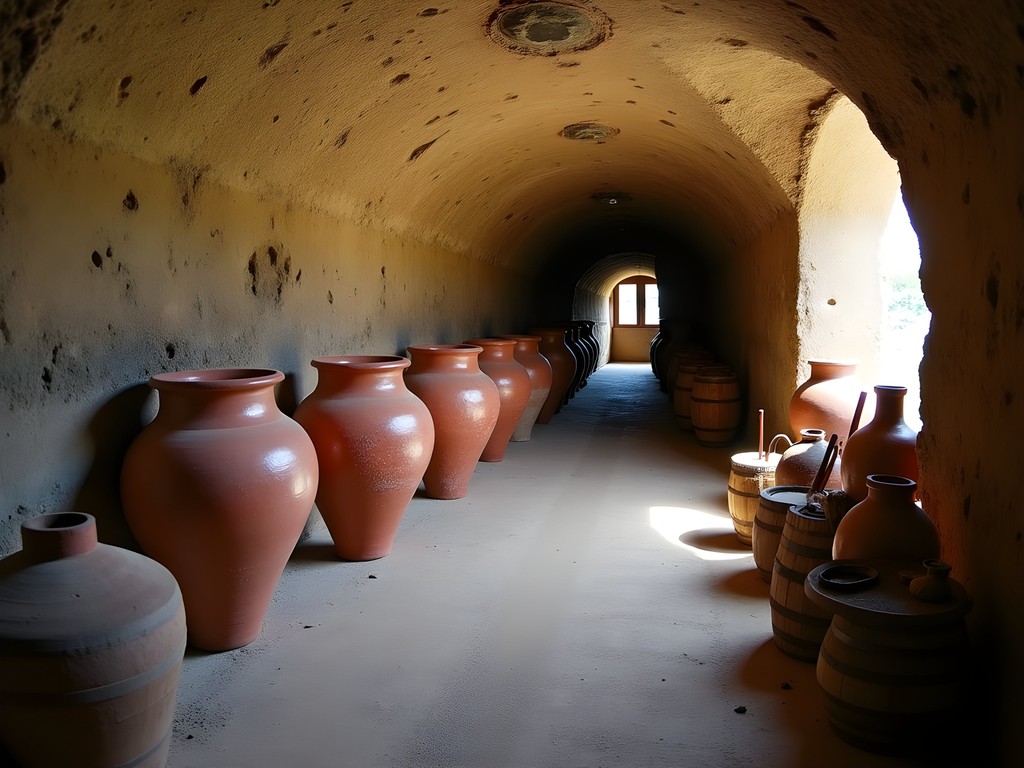
💡 Pro Tips
- Visit smaller family wineries like Gavalas or Hatzidakis for more personalized experiences and traditional methods
- Purchase vinsanto as a long-term investment—properly stored bottles will continue improving for decades
- Look for wines from 'pre-phylloxera' vines, which are ungrafted and often over a century old
Market Pilgrimage: Sourcing Like a Local
To truly understand Santorini's culinary ecosystem, one must follow the supply chain to its source. My systematic exploration led me to the farmers' market in Fira, held every Wednesday from 8 AM to 2 PM—a decentralized network of producers that keeps the island's food traditions alive despite increasing tourism pressure.
Unlike the polished presentations at high-end restaurants, the market offers unfiltered access to the island's agricultural output. Here, I found elderly women selling capers they had personally foraged from rocky outcroppings, their gnarled hands a testament to decades of working this unforgiving terrain. These capers—smaller and more intensely flavored than any I've tasted elsewhere—represent a direct connection to Santorini's volcanic soil.
At another stall, a third-generation tomato farmer displayed his prized Santorini tomatinia—cherry tomatoes with PDO (Protected Designation of Origin) status. Their concentrated sweetness comes from the plants' adaptation to water scarcity, developing smaller fruits with intensified flavor compounds.
"Take them home, crush them raw with a fork, add our oregano and oil—that's all you need," he instructed me, demonstrating the minimalist approach that defines authentic Santorinian cuisine.
For those staying in accommodations with kitchen access, I discovered Faros Market in Akrotiri offers an exceptional selection of local products, including the island's renowned fava beans, white eggplants, and chloro cheese—a fresh goat cheese that's increasingly rare as traditional shepherding declines.
The most valuable discovery of my market research was meeting Yiannis, a fisherman who supplies many of the island's top restaurants. For visitors willing to wake before dawn, he welcomes observers at Vlychada port as the boats return with their catch around 6 AM. Watching the fishermen sort through red mullet, sea bream, and the prized skaros (parrotfish) provided insights into the marine ecosystem that no menu description could capture.
To preserve these culinary discoveries at home, I use my spice grinder to process Santorini's unique herbs and sea salt into custom blends that recapture the island's distinctive flavor profile months after my return.
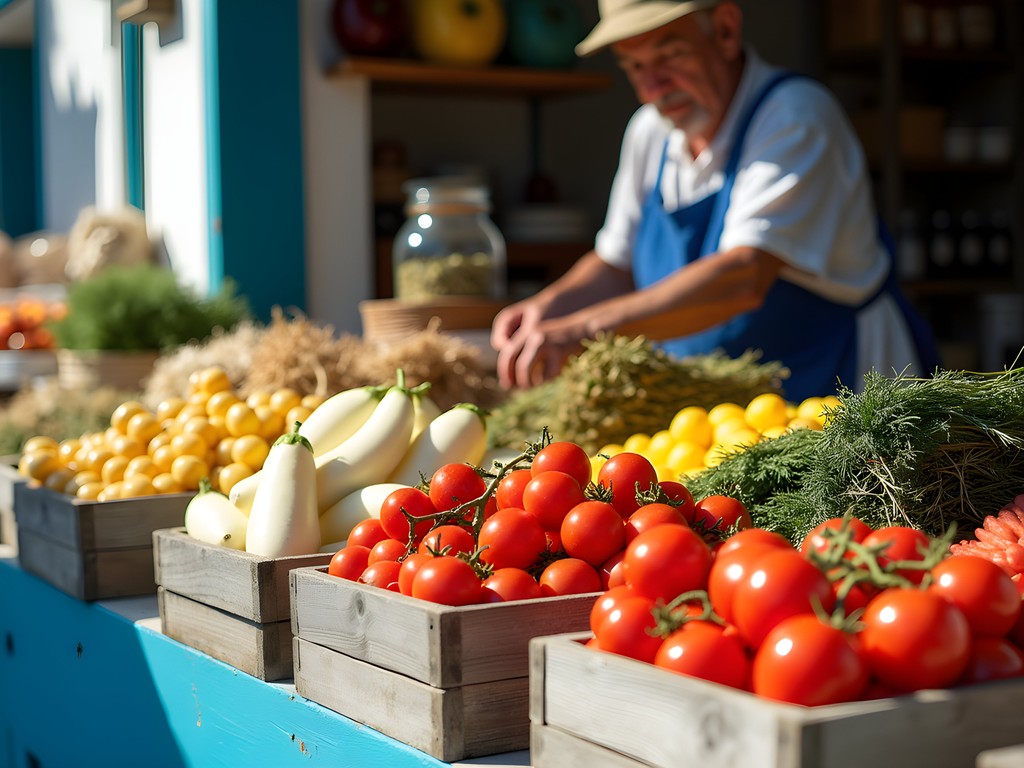
💡 Pro Tips
- Visit the Fira farmers' market on Wednesday mornings to interact directly with producers
- Look for PDO-certified products like fava Santorinis, tomato paste, and white eggplants for authentic flavors
- Ask vendors for serving suggestions—their traditional preparation methods often differ from restaurant versions
Final Thoughts
As my week in Santorini drew to a close, I found myself at Domaine Hatzidakis for one final tasting, watching the sunset cast its golden light across the ancient kouloura vines. These twisted, basket-shaped plants—some over a century old—embody what draws me to both ancient civilizations and blockchain technology: resilient systems that preserve essential knowledge across time. Santorini's gastronomic heritage represents a distributed ledger of cultural wisdom, maintained not through digital consensus but through the hands of winemakers, fishermen, and cooks who have adapted their craft to this volcanic crucible. Whether you're analyzing the minerality in an Assyrtiko or contemplating the ingenious simplicity of tomatokeftedes, Santorini offers a rare opportunity to taste history itself—a sensory blockchain of flavors that connects us to thousands of years of human ingenuity. I invite you to make your own pilgrimage to this remarkable island, where every meal becomes a transaction with the past and every wine glass holds the accumulated wisdom of generations.
✨ Key Takeaways
- Santorini's indigenous Assyrtiko grape produces uniquely mineral-driven wines thanks to the island's volcanic terroir
- Traditional kouloura vine training methods represent an ancient agricultural knowledge system perfectly adapted to the harsh environment
- Local specialties like fava, white eggplants, and cherry tomatoes offer concentrated flavors due to their adaptation to water scarcity
- Cliffside dining combines culinary excellence with spectacular caldera views for a multisensory experience
📋 Practical Information
Best Time to Visit
April through early June
Budget Estimate
$300-500 per day for luxury experience
Recommended Duration
7 days
Difficulty Level
Beginner

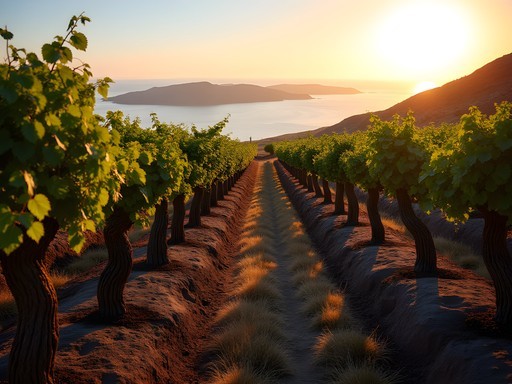

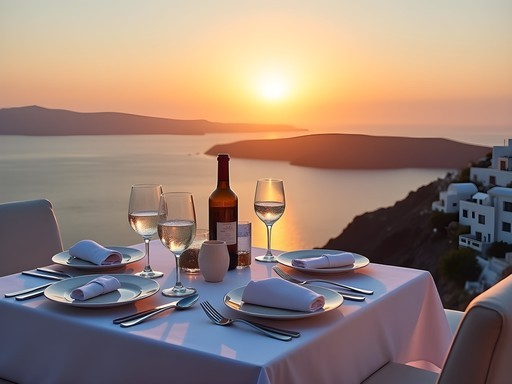

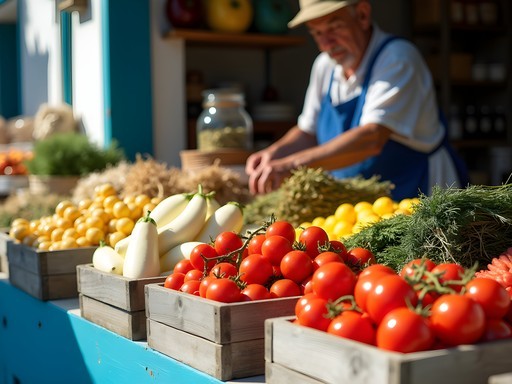




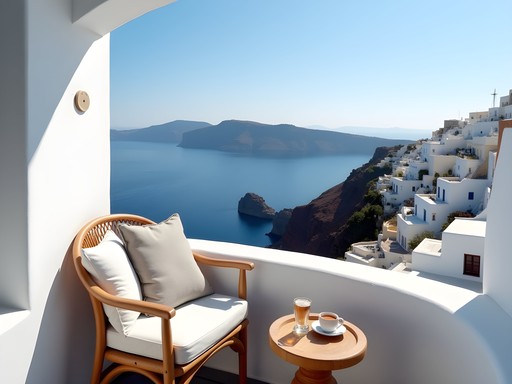

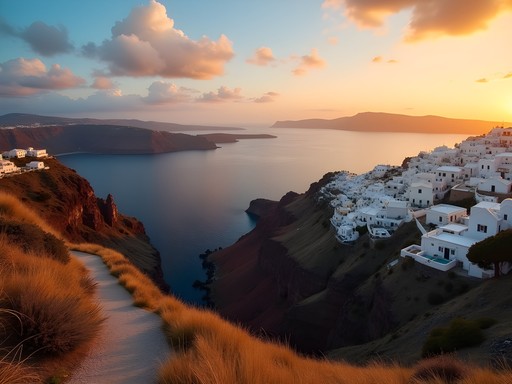
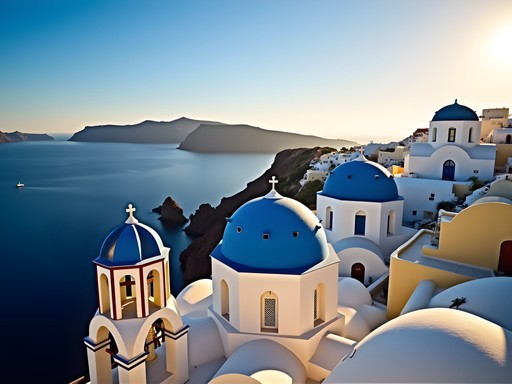


Comments
John Hart
Having lived in Japan for decades, I've developed an appreciation for how geography shapes cuisine. Your section on 'The Sacred Geometry of Santorinian Cuisine' resonated deeply with me. The parallels between Santorini's sparse landscape and its concentrated flavors mirror what I've observed in Japan's island terroirs. I visited Santorini last year and was struck by the tomato fritters (tomatokeftedes) - how such intense flavor comes from those small tomatoes grown in volcanic soil! Did you happen to visit Metaxi Mas in Exo Gonia? It's away from the caldera but serves perhaps the most authentic local cuisine I found on the island. Their fava with capers and the grilled octopus were transcendent.
escapestar
OMG those sunset photos with the wine glasses in the foreground are STUNNING! 😍 Major travel envy right now! Did you need reservations for most of the wineries or can you just show up?
Connor Robinson
Thanks! Most wineries definitely need reservations, especially during high season (June-September). The sunset tastings book up weeks in advance!
escapestar
Good to know! Planning for next summer so I'll book early!
Dylan Turner
Connor, your piece captures the essence of Santorini's wine culture beautifully. I've been covering Mediterranean wine regions for over a decade, and Santorini stands apart precisely because of what you highlighted - that incredible volcanic terroir. The way the assyrtiko grape expresses itself there is unmatched. I'd add that Gaia Wines is also worth a visit - their tasting room sits right on the black sand beach at Kamari, and their Wild Ferment Assyrtiko shows a different interpretation of the grape. For those planning a visit, I'd recommend bringing a proper wine carrier if you plan to bring bottles home. The local packaging at shops isn't always sufficient for air travel.
wildmood
Thanks for the Gaia recommendation! Adding that to my list for next time. And good point about transport - I wrapped mine in clothes but was nervous the whole flight home!
citynomad
Those sunset wine tastings look incredible! Adding this to my bucket list.
wildmood
I visited Santorini last summer and was blown away by those basket-trained vines! They look almost alien against the volcanic soil. We did a tasting at Santo Wines with that incredible caldera view, but I wish I'd known about Domaine Hatzidakis before going. The Assyrtiko there sounds incredible. Did anyone else notice how the wine has this distinct mineral quality that you just don't find elsewhere? Something about that volcanic soil really comes through.
oceanzone
Yes! That minerality is so unique to Santorini. We actually brought back two bottles of Assyrtiko and had friends over for a Greek-themed dinner. Not quite the same as drinking it cliffside, but still amazing.
wildmood
Smart move! I'm kicking myself for not bringing more back. Did you try any of the sweet Vinsanto wine while you were there?
SunsetChaser
That final sunset at Domaine Hatzidakis sounds magical! Adding this to my bucket list right now.
GreekIslandHopper
Going to Santorini in September! Any specific wineries I absolutely shouldn't miss? And is it worth booking a guided tour or better to explore on our own?
Connor Robinson
Domaine Sigalas and Hatzidakis are must-visits! If you're serious about wine, a guided tour helps with transportation (driving after tastings isn't ideal) and provides context about the unique viticulture. But if you prefer independence, just book tastings directly and use taxis between wineries. September is harvest time - you might see the process in action!
GreekIslandHopper
Thanks Connor! Definitely going to check out those two. Good point about the driving - maybe a morning tour and then explore on our own after.
Sage Dixon
Connor, your description of the 'Sacred Geometry' of Santorinian cuisine took me right back to my last visit! I spent three weeks island-hopping through the Cyclades last year, but Santorini's food scene was the standout. The way they balance the intensity of those volcanic-soil ingredients with simple preparation is magical. For anyone planning a trip, I highly recommend taking a cooking class in Oia - I learned how to make those incredible white eggplant dishes and the proper way to serve mezze. I used my pocket wine guide to help me understand the local varietals better, which made the tastings so much more meaningful. Did you make it to Metaxi Mas in Exo Gonia? That place changed my understanding of what Greek food could be!
Connor Robinson
Metaxi Mas was actually one of my favorite meals on the island! That slow-cooked lamb with the white eggplant purée was transcendent. And yes, the balance between intensity and simplicity is exactly what makes the cuisine so special. I'm curious - did you try any of the unusual dessert wines?
Sage Dixon
Absolutely! The Vinsanto blew me away - that amber color and those complex honey and dried fruit notes. I brought two bottles home and I'm saving them for special occasions. The aging process they use is fascinating!
WineWanderer
Those basket-trained vines look incredible in your photos! Never seen anything like that before.
islandrider
Just got back from Santorini last week and this post is giving me serious withdrawal! Those basket-trained vines are so unique - never seen anything like them before. We did a tasting at Santo Wines and watched the sunset from their terrace. That Assyrtiko wine with the minerality you described is unreal! Did you try any of the tomato fritters? They were my absolute favorite with the wine.
Sage Dixon
Those tomato fritters (tomatokeftedes) are incredible! Something about the volcanic soil makes Santorini tomatoes so intensely flavored. Did you visit any of the smaller family wineries? I found some hidden gems last time I was there.
islandrider
We stumbled upon this tiny place called Gavalas Winery in Megalochori - family run for generations! The owner poured everything himself and told us stories about harvesting during different volcanic eruptions. So cool!
Connor Robinson
Gavalas is a treasure! Their Vinsanto is among my favorites on the island. So glad you discovered it!
Venture X
Premium card with 2X miles, $300 travel credit, Priority Pass